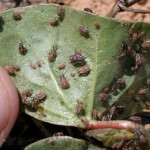 Beginning Friday and continuing over the weekend I received a few calls about false chinch bug infestations in cotton and soybeans. This is an occasional but potentially serious pest of these crops during the seedling stages. They are most often associated with reduced tillage where delayed burndowns allowed certain weeds to persist into the field close to or after planting. My colleague, Angus Catchot, just posted an article about this pest on The MSU Crop Blog site at http://www.mississippi-crops.com/2011/06/02/with-dry-weather-watch-for-false-chinch-bug-outbreaks/. He included some great pictures if you are not familiar with this pest.
Beginning Friday and continuing over the weekend I received a few calls about false chinch bug infestations in cotton and soybeans. This is an occasional but potentially serious pest of these crops during the seedling stages. They are most often associated with reduced tillage where delayed burndowns allowed certain weeds to persist into the field close to or after planting. My colleague, Angus Catchot, just posted an article about this pest on The MSU Crop Blog site at http://www.mississippi-crops.com/2011/06/02/with-dry-weather-watch-for-false-chinch-bug-outbreaks/. He included some great pictures if you are not familiar with this pest.
False chinch bugs will sometimes invade fields from the edges but also commonly occur in patches where they originate on certain broadleaf weedy hosts. There will often be many under the residue of dead and dying weeds. False chinch bugs can number several dozen or more bugs per plant. They suck the plants dry when they occur in large numbers, and although seed treatments have some activity, they will be overwhelmed by high populations. Serious infestations are usually dominated by the presence of many immatures (nymphs). This pest is difficult to control. In test plots a couple of years back, I got good control with Endigo (5 oz/a), Brigade (5-6 oz/a) and Cobalt (24 oz/a). These products are labeled on both soybean and cotton. Acephate/Orthene and Lorsban/Nufos are hit or miss and so are pyrethroids other than bifenthrin products (e.g., Brigade, Fanfare, Discipline). I would not recommend these products except perhaps as a tank mix at high rates. ULV Malathion at (12-16 oz/a) is also a good treatment if aerial application is possible. Bidrin was an option in cotton, but the new Bidrin label does not allow for high enough rates on small cotton. Consider insecticide treatment anytime false chinch bugs are reducing stands below an acceptable level. Be aware that hotspots often increase with size as the bugs spread out.


